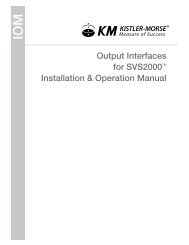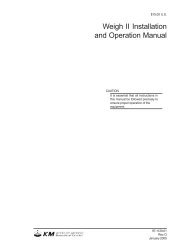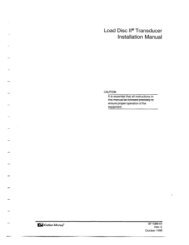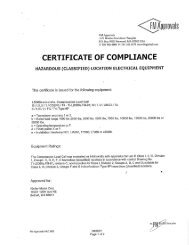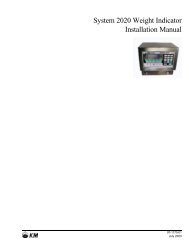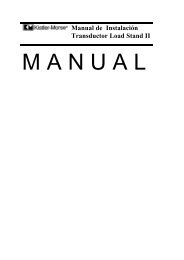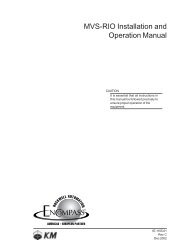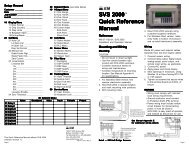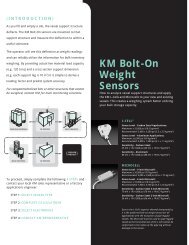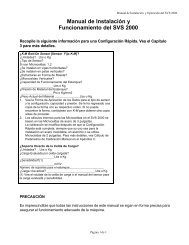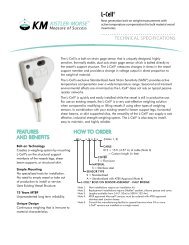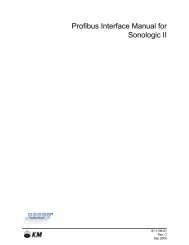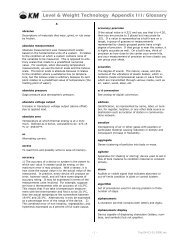STX Signal Transmitter Installation and Operation ... - Kistler-Morse
STX Signal Transmitter Installation and Operation ... - Kistler-Morse
STX Signal Transmitter Installation and Operation ... - Kistler-Morse
Create successful ePaper yourself
Turn your PDF publications into a flip-book with our unique Google optimized e-Paper software.
Chapter 3. St<strong>and</strong>-Alone <strong>STX</strong> Analog Calibration <strong>and</strong> Setup<br />
Chapter 3. St<strong>and</strong>-Alone <strong>STX</strong><br />
Analog Calibration <strong>and</strong> Setup<br />
Introduction<br />
This chapter contains the procedures to<br />
perform an analog calibration, set up system<br />
parameters for the <strong>STX</strong>, <strong>and</strong> use the <strong>STX</strong>’s<br />
remote tare feature.<br />
Analog Calibration<br />
Analog calibration calibrates the <strong>STX</strong>’s<br />
‘analog engine’ with the sensors wired to the<br />
<strong>STX</strong> (for example, L-Cells, Microcells, Load<br />
St<strong>and</strong> II, Load Disc II, or Load Link):<br />
• When the <strong>STX</strong> is in Analog Mode, the<br />
current output transmitted by the <strong>STX</strong><br />
PCB is based on the analog calibration.<br />
However, any digital outputs (such as<br />
to an MVS or PLC) are based on the<br />
digital calibration.<br />
• When the <strong>STX</strong> is in Digital Mode, the<br />
current output transmitted by the <strong>STX</strong><br />
PCB <strong>and</strong> any digital outputs (such as<br />
to an MVS or PLC) are based on the<br />
digital calibration.<br />
The calibration described in this chapter<br />
is valid only when the <strong>STX</strong> is in Analog<br />
Mode. If the <strong>STX</strong> is in Digital Mode, the <strong>STX</strong><br />
will ignore the analog calibration. Refer to the<br />
appropriate reference for digital calibration:<br />
• Chapter 7, MVS-<strong>STX</strong> Calibration Menu<br />
• Appendix B, Serial Comm<strong>and</strong>s<br />
• Applicable PLC manual —<br />
KM-RIO <strong>Installation</strong> <strong>and</strong> <strong>Operation</strong><br />
Manual, MVS-RIO <strong>Installation</strong> <strong>and</strong><br />
<strong>Operation</strong> Manual, or MVS-Modbus<br />
<strong>Installation</strong> <strong>and</strong> <strong>Operation</strong> Manual<br />
Note<br />
Before performing analog calibration,<br />
you must set up the current output<br />
mode (0-20 or 4-20 mA). See Setting<br />
Up Current Output Operating Mode.<br />
Setting Up Current<br />
Output Operating<br />
Mode (0-20 or 4-20 mA)<br />
Note<br />
The default mode is 4-20 mA. If that<br />
is the desired mode of operation,<br />
skip this section <strong>and</strong> proceed to<br />
Analog Calibration.<br />
The <strong>STX</strong>’s current transmitter can be set up<br />
to output 0-20 mA or 4-20 mA. The 0-20<br />
mode has a minimum current output of 0 mA<br />
<strong>and</strong> a maximum output of 20 mA. The 4-20<br />
mode has a minimum current output of 4 mA<br />
<strong>and</strong> a maximum output of 20 mA. Follow this<br />
procedure to select the operating mode:<br />
1. If the <strong>STX</strong> is off, apply power <strong>and</strong> let it<br />
warm up for at least 15 minutes.<br />
2. Place SW3 in the position corresponding<br />
to the desired mode of operation, 0-20 or<br />
4-20 mA.<br />
3. Immediately after placing SW3 in the<br />
desired position, press SW1 <strong>and</strong> SW2<br />
simultaneously to enter the selected<br />
mode in memory.<br />
Note<br />
If you do not press SW1 <strong>and</strong> SW2<br />
within 15 seconds of placing SW3 in<br />
the desired position, the <strong>STX</strong> disables<br />
SW1 <strong>and</strong> SW2. If this occurs, move<br />
SW3 out of <strong>and</strong> back into the desired<br />
position <strong>and</strong> repeat Step 3.<br />
Analog Calibration<br />
There are three methods for performing an<br />
analog calibration:<br />
• High-accuracy calibration<br />
• Calibration by adding a known quantity<br />
of material<br />
• Calibration by subtracting a known<br />
quantity of material<br />
3-1



